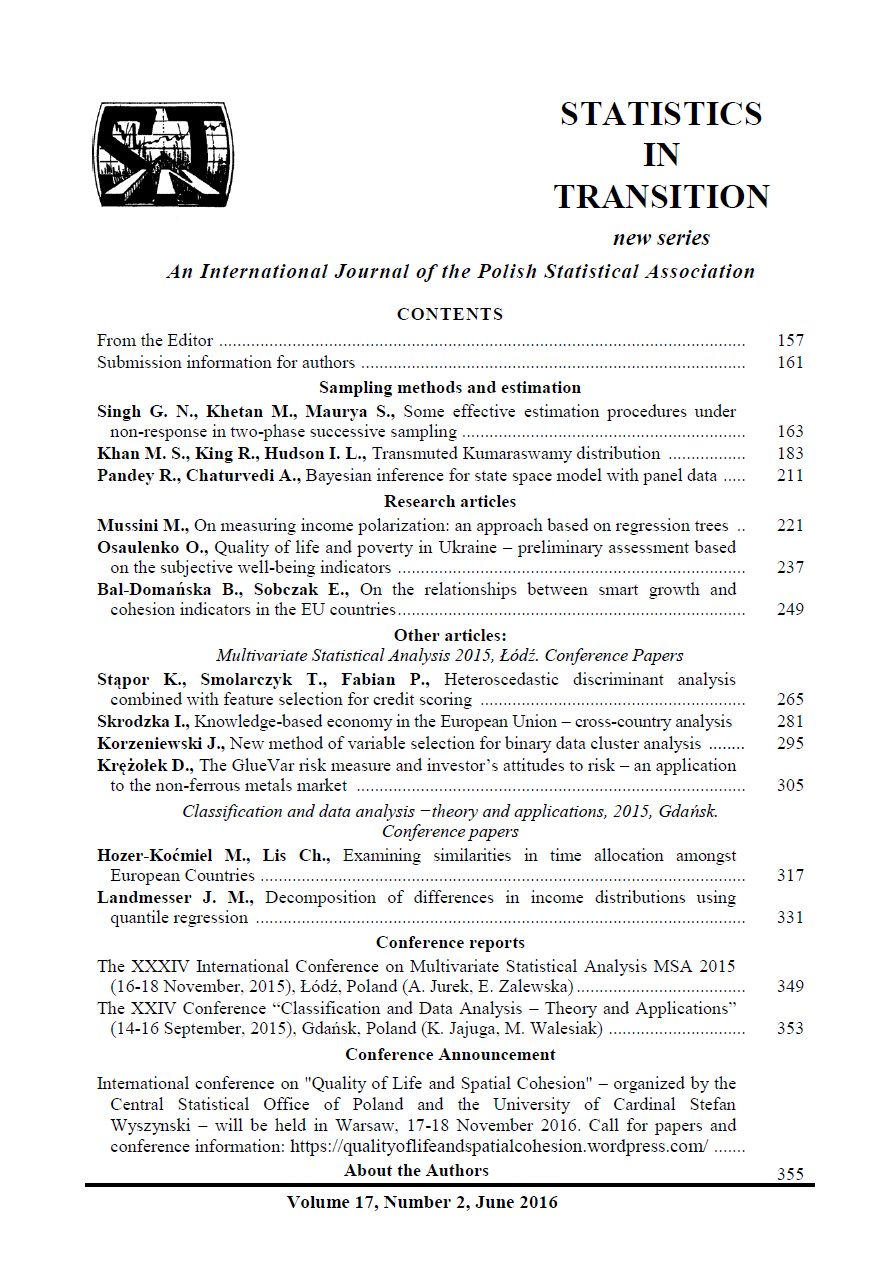ARTICLE
ABSTRACT
The aim of the article is to analyse the similarities between the selected European countries in terms of time allocation. Time allocation has been defined as the daily distribution of time to various activities. Professional work time, domestic work time and leisure time are the most important for the economic approach. It has been proved that there are coherent groups of countries with similar structure of time allocation. The taxonomic methods used in order to verify the thesis included: cluster analysis, k-means method, generalised distance measure GDM and interval taxonomic method TMI. The analysis was performed on the basis of HETUS data.
KEYWORDS
time allocation, cluster analysis, k-means method, generalised distance measure GDM, interval taxonomic method TMI, HETUS survey.
REFERENCES
ANTONOPOULOS, R., MASTERSON, T., ZACHRIAS, A., (2012). It’s about ‘time’: Why time deficits matter for poverty. Levy Economics Institute of Bard College Public Policy Brief, No. 126.
BECKER, G. S., (1965). A theory of the Allocation of Time. Economic Journal, September 1965.
BERGMANN, F., (2014). New Work Life: New Work New Culture: New Business Enterprise. Flow Zone EDITION.
EASTERLIN, R. A., (2004). The Economics of Happiness. Daedalus, Vol. 133, No. 2, Spring 2004.
FOLBRE, N., (1994). Who Takes Care of the Kids? Gender and the structures of constraint. Routledge, London.
HOZER-KOĆMIEL, M., (2008). Gender Mainstreaming in economics. Woman work time and value distribution. US, IADiPG, Szczecin.
HOZER-KOĆMIEL, M., LIS, CH., (2015). Klasyfikacja krajów nadbałtyckich ze względu na czas prac wykonywanych w gospodarstwie domowym [Classification of the Baltic states in terms of duration of works performed in a household], Taksonomia 25, Prace Naukowe Uniwersytetu Ekonomicznego we Wrocławiu, No. 385.
JAJUGA, K., (1993). Statystyczna analiza wielowymiarowa [Statistical multidimensional analysis], PWN, Warsaw.
LIS, CH., (2013). Wartość dodana brutto i jej znaczenie w procesie akumulacji kapitału w świetle teorii wzrostu i konwergencji. Podejście taksonomiczne [Gross Value Added and Its Significance in the Capital Formation with Reference to Growth and Convergence Theories, A Taxonomic Approach]. Publishing House Volumina.pl, Szczecin.
PIETILA, H., (1997).The triangle of human economy: household - cultivation -industrial production. An attempt at making the human economy visible in toto, Ecological Economics, No 20.
POCIECHA, J., PODOLEC, B., SOKOŁOWSKI, A., ZAJĄC, K., (1988). Metody taksonomiczne w badaniach społeczno-ekonomicznych [Taxonomic methods in socio-economic studies], PWN, Warsaw.
STIGLIZ, J. E., SEN, A., FITOUSSI, J. P., (2010). Report by the Commission on the Measurement of Economic Performance and Social Progress.
STRAHL, D., WALESIAK, M., (1997). Normalizacja zmiennych w skali przedziałowej i ilorazowej w referencyjnym systemie granicznym [Normalization of variables in interval and ratio scales in the border reference system]. Przegląd Statystyczny, No. 1, Warsaw.
WALESIAK, M., (2000). Propozycja uogólnionej miary odległości w statystycznej analizie wielowymiarowej [The Proposal of the Generalised Distance Measure in Multivariate Statistical Analysis], In J. Paradysz (ed.), Statystyka regionalna w służbie samorządu lokalnego i biznesu [Regional statistics in the service of local self-government and business]. Wydawnictwo AE, Poznań.
WALESIAK, M., (2011). Uogólniona miara odległości GDM w statystycznej analizie wielowymiarowej z wykorzystaniem programu R [GDM Generalized distance measure in multivariate statistical analysis using R software]. Wydawnictwo Uniwersytetu Ekonomicznego we Wrocławiu. Wrocław
